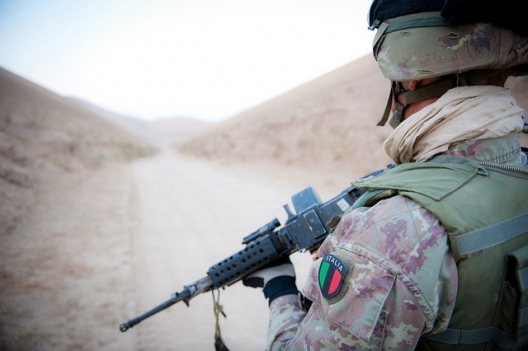 In 2012, total defence expenditure of the 26 EDA pMS (1) amounted to € 189.6 billion – a reduction of € 1.1 billion or 0.6% compared to 2011. It represented approximately 1.50% of their total GDP and 3.04% of their total government expenditure, both values being the lowest since 2006. In real terms (2), total defence expenditure has been decreasing since 2006. During the period from 2006 to 2011, it dropped by € 21 billion or almost 10% and between 2011 and 2012 it reduced further by almost 3%.
In 2012, total defence expenditure of the 26 EDA pMS (1) amounted to € 189.6 billion – a reduction of € 1.1 billion or 0.6% compared to 2011. It represented approximately 1.50% of their total GDP and 3.04% of their total government expenditure, both values being the lowest since 2006. In real terms (2), total defence expenditure has been decreasing since 2006. During the period from 2006 to 2011, it dropped by € 21 billion or almost 10% and between 2011 and 2012 it reduced further by almost 3%.
Equipment procurement increases, but R&D expenditure reduces
Personnel-related expenditure decreased by almost 3% from 2011 to 2012 and reached its lowest level since 2006 (€ 95.7 billion). Nevertheless, it continues to account for over 50% of total defence expenditure. The second biggest component – operation and maintenance expenditure – also decreased by almost 3% and accounted for 23.7% (€ 44.8 billion) of total defence expenditure. On the other hand, after a sharp decrease in 2011, defence investment, comprising equipment procurement and R&D expenditure, increased by over 5% in 2012 to reach the same level it was in 2006 (€ 39.0 billion or 20.6% of total expenditure). But the two components of investment moved in different directions: while equipment procurement increased by 17% to € 34.2 billion (18.0% of total expenditure), close to the highest level achieved in 2010, R&D expenditure experienced the sharpest decrease since 2006 (-38%) and amounted to € 4.8 billion (2.5% of total expenditure), half its 2006 value. As for R&T (3), after a slight increase in 2011, it reduced to € 1.93 billion (1.02% of total expenditure), both being the lowest values since 2006.
Collaboration: increases in procurement but decreases in R&T
2012 data shows a significant decrease in collaborative expenditure. This is partially due to the fact that one EDA pMS was not able to provide data on collaboration this year. If aggregated data of the 25 pMS for which collaborative figures are available is compared, between 2011 and 2012 collaborative equipment procurement increased by 10% while European collaboration increased by 16.5% and accounted for 95.5% of total collaborative equipment procurement. As for R&T, expenditure on collaborative projects and programmes decreased by almost 15% during the same period. European collaborative R&T expenditure experienced an even sharpreer decrease of 38% and accounted for 67.6% of total collaborative R&T expenditure.
Number of military personnel continues to drop while expenditure and investment per military increases
2012 saw the sixth consecutive reduction in military personnel (77.5% of total staff working in defence, the lowest ratio since 2006) and decreased by 6.3% to 1.45 million. On the other hand, the number of civilian personnel increased for the first time since 2006 by 12.8% to 422 315. Whilst military personnel numbers reduced, defence expenditure per military increased by over 6% reaching € 130 457. Defence investment per military also increased by over 12% and stood at almost € 26 821.
Reduction in troops deployed and in costs of operations
As regards deployed operations outside the EU territory, similarly to the last three years, the average number of troops deployed decreased both in absolute terms (from 53 744 to 49 550) and as a share of military personnel (from 3.5% to 3.4%) and is now at its lowest level since 2006. For the first time since 2006, costs related to deployed operations decreased by 8% to € 10.8 billion or 5.7% of total defence expenditure. Operations costs per military deployed also marginally decreased for the first time and stood at € 217 000 in 2012.
Progress made on one out of four collective benchmarks
In 2007, EDA pMS agreed on a set of four collective benchmarks for investment. There is no obligation in terms of timeline or adoption of these benchmarks into national targets.
In 2012, only one of the four indicators made progress towards the benchmarks. Due to an increase in defence equipment procurement expenditure, the proportion of investment (equipment procurement and R&D) of total defence expenditure increased from 19.4% to 20.6% thus exceeding the agreed target of 20%. After an increase in 2011, the share of R&T expenditure in total defence expenditure decreased to its lowest level since 2006: 1.02% (the benchmark is 2%).
Due to incomplete collaborative data, it is not possible to measure progress towards the two other benchmarks: European collaborative equipment procurement as a percentage of total equipment procurement (the benchmark is 35%) and European collaborative defence R&T as a percentage of total defence R&T (the benchmark is 20%).
_______
(1) Data in this publication does not include Croatia which became the 27th EDA Member State on 1 July 2013, and Denmark which is not an EDA Member State.
(2) In order to measure real growth and ensure a “real” comparison between years, inflation needs to be taken into account. Thus, data from 2006 to 2011 has been inflated to 2012 economic conditions (Source of deflator: European Commission ECFIN – based on weight of EU 27).
(3) R&T is a subset of R&D which includes only basic research, applied research and technology demonstration, leaving out expenditure for demonstration or development for which a decision to procure has been taken.
Image: Italian soldier in Afghanistan (photo: SSG Romain Beaulinette/ISAF)
